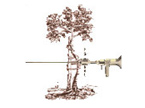Dupuytren’s disease is a genetically inherited disorder which primarily involves the palmar aponeourosis and its digital prolongations.
The primary pathological change is in the fascial tissues of the palm which results in thickening, cord-like formation of contractile bands, and then eventual contractures at the level of the interphalangeal joints. On occasion, it can be associated with other diseases such as diabetes, epilepsy, or alcoholism.
Certain contributing factors increase the likelihood of significant progression. These include a strong family history, early onset of disease, rather extensive bilateral involvement, and the presence of disease in other areas such as the plantar regions of the feet. These contributing factors may lead to a more aggressive course of the disease and possibly even an operation at an earlier age.
The disease is seen much more frequently in men than in women and has a tendency to usually appear between the ages of 40 and 60.
Dupuytren’s disease has over a 65% chance of being bilateral, and can involve other areas such as the foot, the dorsum of the hand, and other fibrous tissues. It is a slowly progressive disorder which may have periods of temporary arrest, or even a rapid progression. After the nodules have formed, the tendency is for these to coalesce into a cord, which will lead to a flexion contracture at the MCP joints and the PIP joints. The skin itself can be infiltrated by the disease.
Initial treatment is always non-surgical. This would consist of continued observation for progression of the problem. As the disease does not involve any pain, there is no reason for the excision of the nodules or cords until contractures in digits have occurred. If a contracture becomes bothersome or a nodule becomes painful, or if the contracture in the MCPJ exceeds 30 degrees or any involvement at the PIP joint occurs, we would recommend surgical excision. This would consist of a palmar and digital fasciectomy utilizing an axillary block anesthetic. A skin graft taken from the forearm is almost always used. Long term results are usually quite good. If contractures have developed at the MCPJ and PIP joint, they can usually be corrected to within half of the preoperative level. Recurrence of the disease is possible, but this is usually not associated with further contracture necessitating surgery.


